Evolution – The Ultimate Journey
Image yourself way back in time, about 50 million years or so ago. The giant dinosaurs are long gone, swept away a cataclysmic astroid strike. Your standing by a marshy river that flows into a shallow sea. Splashing amongst the reeds is a very strange looking animals fishing for its dinner and is something a bit like an Otter crossed with a small deer, covered in fur with a long nose. It’s hard to believe that your watching an early ancestor of our modern day whales as its starts the journey back into the Earth oceans. A journey that will take millions of years, throw up some truly strange looking animals and eventually lead to the largest animals to have ever lived.
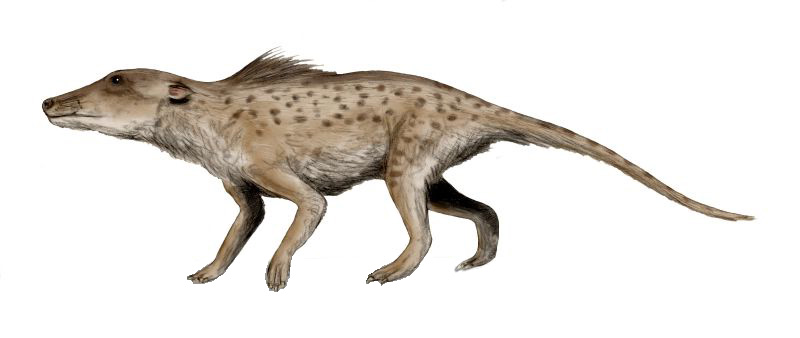
Like all great detective stories you begin at the end and working backwards piece together all the facts until you understand what happened and how it all fits together. To help us grasp this Charles Darwin urged us to consider our own hand to help us understand evolution. “What can be more curious,” he asked, “than that the hand of a man, formed for grasping, that of a mole for digging, the leg of the horse, the paddle of the porpoise, and the wing of the bat, should all be constructed on the same pattern, and should include similar bones, in the same relative positions?”
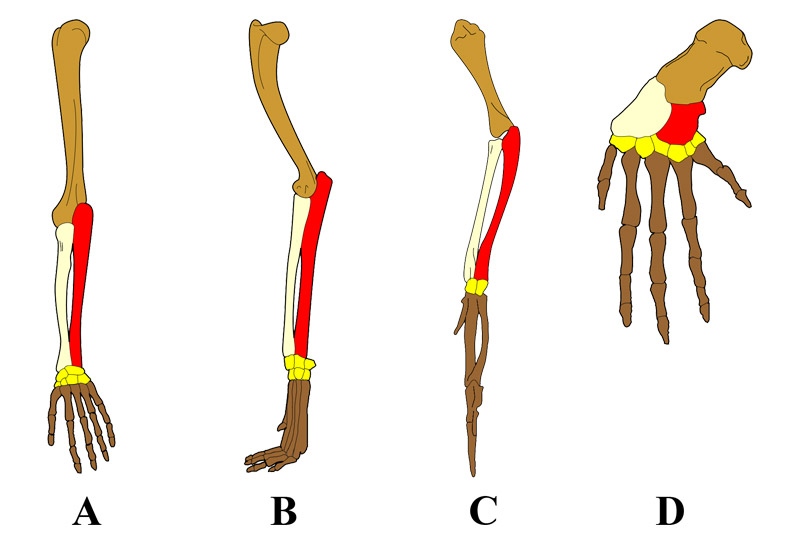
Darwin’s explanation was simple, all these different animals from us, to moles, to horses, to whales and to even bats had at some point shared a common ancestor that had limbs with digits. Its various descendants had evolved differently as they adapted to different environments, tasks and needs. But in doing so they never lost their anatomical similarities that revealed their kinship.
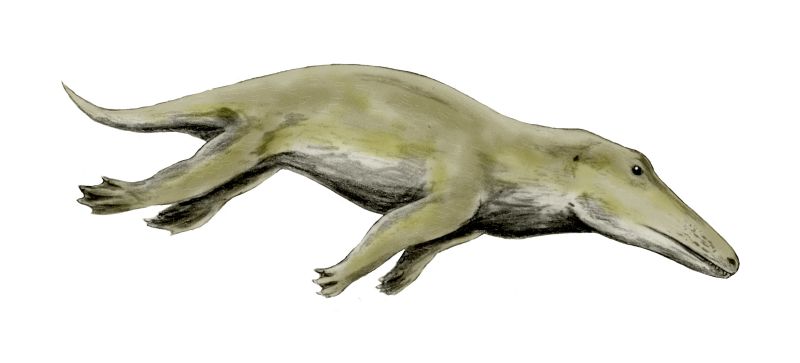
The Mammals
Life first started a very long time ago in the oceans and leaving it to conquer the land was a huge evolutionary leap for life on Earth. Over hundreds of million of years the great dinosaurs came to dominated our planet. The first mammals evolved too but remained quietly in the background. It may have stayed this way had it not been for an asteroid strike some 65 million years ago that caused the mass extinction of the dinosaurs. This gave mammals their opportunity to move out of the shadows and over many millions of years come to inhabit the land, sea and the air. Mammals proved to be very good at adapting to meet the requirements each of these very different environments.
What is so remarkable about the evolution of whales is that they started off nothing like the animals we see today, small, living on land and covered in fur. Evolutionary scientists faced a lot of challenges telling their story and understand how these often very strange looking animals evolved from amphibious semi aquatic animals living on the waters edge to the giants of the oceans today.
This is their story.

The Earths History
Ok now before we get to the story of our whales we need to have a little talk about our favorite planet so strap yourself in for a little bit of geology!
To understand the Earth geological history scientists have divided the layers of rocks into a chronological dating system referred to as the geologic time scale (GTS). This allows anyone studying the Earths history to work out the relationships of events that happened anywhere on Earth by the layer of rock in which they are found in. The geologic time scale is broken up into very large periods of time called Eons, large periods of time the Era’s, then Epochs and finally Ages.
Now without getting ourselves all in a muddle the important thing to know is that whales first appeared around 50 million years ago during a epoch known as the Eocene which lasted from 56 to 33.9 million years ago.
Lots of new animals appeared during this time so the name Eocene comes from the Ancient Greek ἠώς (ēṓs, “dawn”) and καινός (kainós, “new”). The Eocene is then divided into smaller subdivisions, the early Ypresian, middle Lutetian and Bartonian and late Priabonian ages.
The Eocene 56 to 33.9 million years ago
Priabonian 33.9 – 38 million years ago (Late)
Bartonian 37.8 – 41million years ago (Middle)
Lutetian 41.2 – 47.8 million years ago (Middle)
Ypresian 47.8 – 56 million years ago (Early)
The Oligocene 33.9 to 23 million years ago
Chattian 23 – 27.8 million years ago (Late)
Rupelian 27.8 – 33.9 million years ago (Early)
The Early Whales

Pakicetus, The First Whale! – 50 Million Years Ago
Pakicetus is one of the earliest cetacean discovered with functional legs and is known from fossils discovered in 50 million-year-old river delta deposits in present-day Pakistan. It is believed that it lived a semi aquatic life both on land and in water much as Otters do today. About the size of a large dog it retained many features of terrestrial mammals such as four legs, fur, a long snout with nostrils on the end of its nose, ears for hearing in air yet its teeth would suggest that its primarily diet was fish.
The climate of the early Eocene Epoch (56 million to 40 million years ago) was the warmest of the Cenozoic Era, nearly 10°C warmer than the global temperatures of today. Pakicetus lived along the edges of the Tethys Sea, a shallow tropical sea sandwiched inbetween Asia and Europe to the north and Africa and the Indian to the south. Today Pakicetus fossils have been found in the Kuldana Formation in Pakistan. These fossils revealed that Pakicetus had an ear bone with features unique to whales and an ankle bone that linked it to Artiodactyls, a large order of even toed mammals that includes includes hippos, pigs, sheep, cows, deer, giraffes, antelopes, and whales, which are the only aquatic Artiodactyls.
Length: 1 to 2 metres
Weight: 45kg
Diet: Mainly fish as well as other land based animals.

Ambulocetus natans ‘The Walking Whale’ – 50 Million Years Ago
It took whales millions of years to return to the sea. Paleontologists have discovered a number of ‘walking whales’. These are really important transitional species as they show the links between the terrestrial mammals and the early whales.
Ambulocetus received its name as the ‘walking whale’ due to the fact that it was able to swim easily as well as having a limited ability to ‘walk’ on land. It probably spent the majority of its time in water in similar ways to Hippos or seals today.
Ambulocetus body showed changes and adaptations to living in water such as squat strong legs that splayed from its body which meant that on land it probably waddled and pulled its body along with its forelimbs, in a similar way to seals. In the water it swam like a Sea Otter using its gigantic, probably webbed, hind feet. It had a long snout and eyes on the very top of its head, like Hippos do for looking above the water while remaining mostly submerged. Ambulocetus ear structure is very interesting as it appears not to have had external ears so they would have only worked while it was underwater.
Length: 2 to 3 metres
Weight: 245kg
Diet: Fish and other animals that came close to the waters edge.
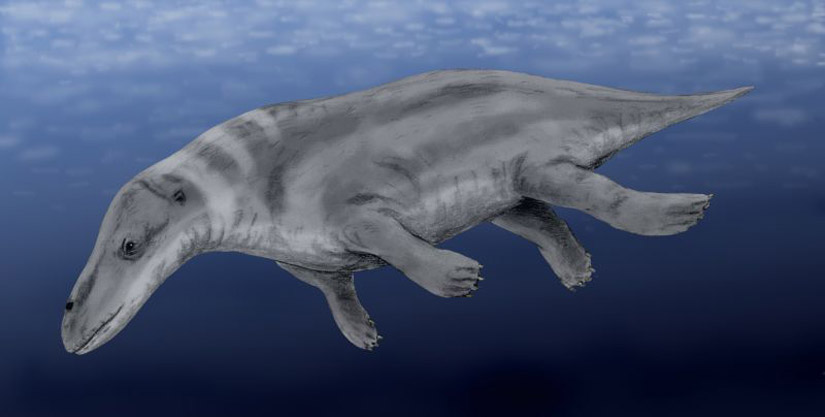
Rodhocetus The ‘Whale Crocodiles’ – 46 Million Years Ago
The early whales looked very different to whales today, so much so that at times its hard to imagine that they are related. Rodhocetus has sometimes been referred to as the Whale Crocodiles because of the way their body shape looks very similar to that of a crocodile, except their a mammal. They are amongst the most important of the early whales as their almost complete fossils skeletons have given us insights into the transition from locomotion on land to life in the ocean.
Rodhocetus bodies show more advanced adaptations for living in water than Ambulocetus does. They were about two and a half metres long with an interesting body that shows a combination of traits that meant they were excellent swimmers with a limited ability to come onto land in the way Crocodiles do. Their heads is long and narrow with a range of different chapped teeth. Modern whales teeth are usually similar in size and shape. The pelvis is attached to the vertebral column, which would enable the hindlimb to support the animal’s body weight for walking, although the pelvis is connected to fewer vertebrae in comparison to modern terrestrial mammals. Also the portion of the vertebral column that is connected to the pelvis is not fused together as it is in land mammals giving it great flexibility and agility in the water. The hind limbs are actually longer than the fore limbs and small bony crests on the toe bones imply that Rodhocetus had webbed feet ideal for swimming, but interestingly the toes themselves appear to have been hoof-shaped. It was originally thought that Rodhocetus might swim like Otters but recent research of their skeletons suggests they may have swum like the Desman (a species of amphibious Eurasian moles) who paddle by extending one hind leg at a time. How much hair they had is still debated but it is thought they might have been a bit like Hippos who are sparsely haired.
Length: 2.5 metres
Weight: 405kg
Diet: Fish
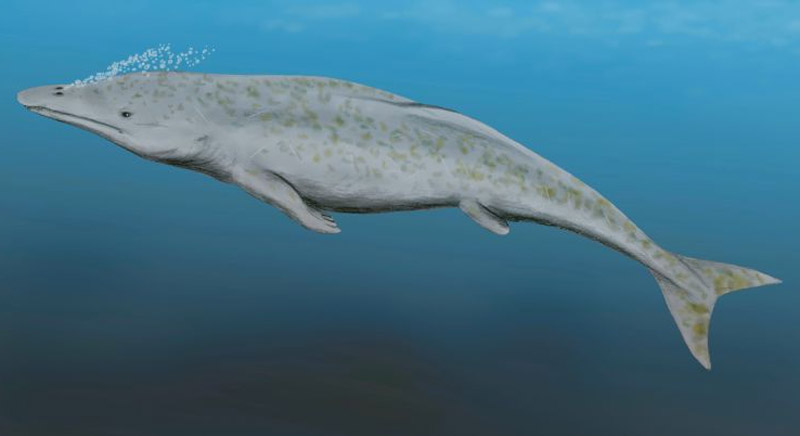
Protocetus ‘The First Whale’ – 45 Million Years Ago
Protocetus atavus (“first whale”) is a primitive cetacean species discovered in present day Egypt. The changes from living on land to returning to life in the water that began Pakicetus through Ambulocetus continued with the further adaptations of Protocetus.
Protocetus had a streamlined, whale-like body around two and half metres long, but was still relatively primitive in many way. The front limbs still had webbed toes, the rear limbs had greatly reduced in size to the point of being considered vestigial. It had a long jaw lined with sharp teeth and whilst it had not yet developed a true blowhole like modern whales the nostrils had already moved backwards from the tip of the nose to mid way along the nose making breathing on the waters surface easier. Its ears also have developed to hear better underwater than in air. The tail bones also suggest that it may have evolved tail flukes similar to those of modern whales.
A dedicated predator Protocetus’s long thin snout is ideally suited for quick opening while submerged. Its front teeth are suited to catching prey where its rear teeth are better suited for slicing.
Length: 2.5 metres
Weight: –
Diet: Fish and other marine animals.
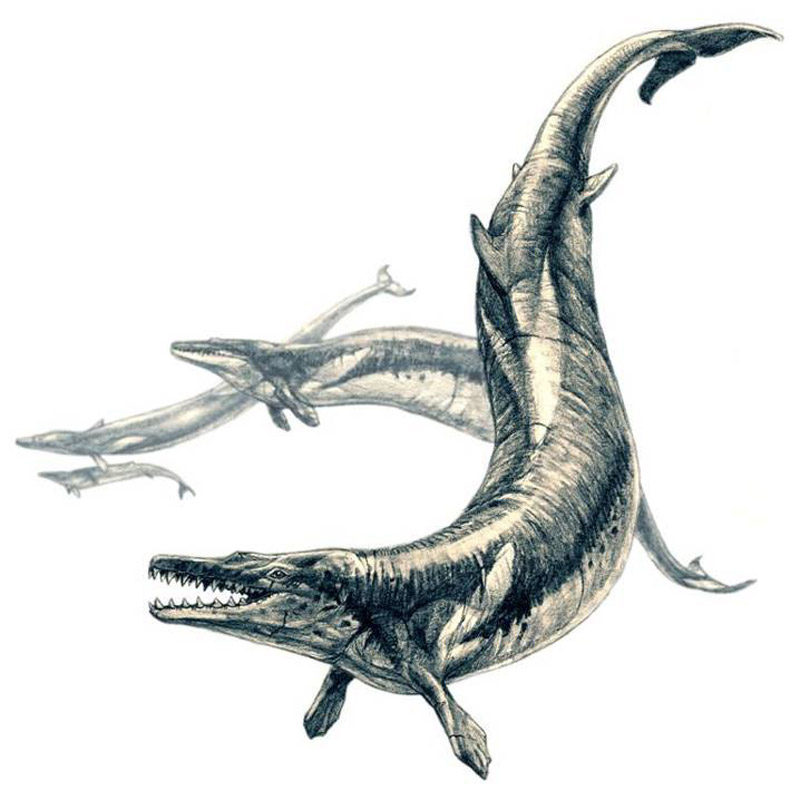
Basilosaurus ‘The King Lizard’ – 45 – 35 Million Years Ago
What a fearsome beast Basilosaurus was! Big with a mouth full of large sharp teeth it was a king of the ancient oceans.
Basilosaurus was vastly different to modern whales and really did look more like an aquatic reptile from the time of the dinosaurs than a whale, hence its name ‘The King Lizard’. This King Lizard was truly a scary looking animal with an extremely long, slender almost eel like body measuring up to 20 metres in length. Its head had a narrow snout lined with teeth of different shapes that gave away its mammal heritage. The nostrils have now moved further back to about half way along the snout. The hindlimb are still there but would have been useless for any sort of terrestrial locomotion. Apart from being tiny the hindlimbs and pelvis were not connected to the spine indicating that they could not support any weight out of water.
Modern whale swim using primarily use the ‘tail’ region. Basilosaurus is characterised by extremely elongate body with a very flexibility in the spine, a high number of vertebrae indicating that they probably used their entire body undulated up and down during swimming. This form of locomotion is ‘anguilliform’, or eel-like; in the case of Basilosaurus, this movement would have been up-down, rather than side to side as in eels and other anguilliform fishes. The vertebrae at the tip of the tail suggest that Basilosaurus had small tail flukes and it is the oldest whale genus with evidence of flukes. Its ribs were also very dense and thickened which may have aided it to be slight negative buoyant helping it to dive and swim effectively.
Basilosaurus was now living in the oceans full time!
Length: 15 to 20 metres
Weight: –
Diet: Fish and other marine animals including other whales.
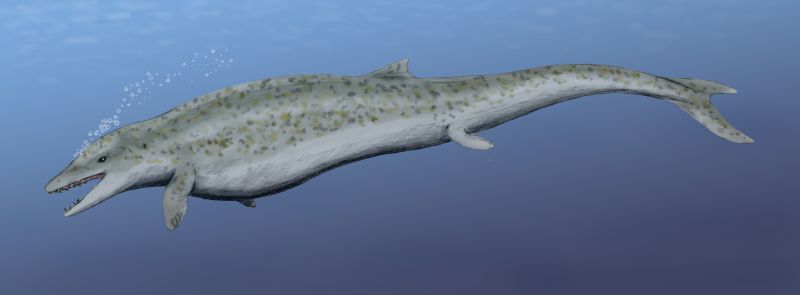
Dorudon The ‘Spear-tooth’ 40 – 34 Million years old
Dorudon atrox is known from the famous “Valley of the Whales” (Wadi al Hitan) in Egypt which forty million years ago was part of Tethys Sea. It is another genus of extinct ancient basilosaurid whales that lived alongside Basilosaurus from 40 to 34 million years ago during the Eocene period.
Dorudon gets its “spear-tooth” name due to the shape of its large triangular, blade-like side teeth (cheek area) that have two widely separated roots, and a coarsely serrated crown. It differs from modern toothed whales by having different shaped teeth in its mouth, modern toothed whales teeth are generally similar in shape thoughout the mouths. It almost certainly lacked the bulbous ‘melon’ that forms the spherical bulge on the forehead of modern toothed whales as its shout was long and narrow.

Dorudon Skeleton (Image PLoS ONE – Wikimedia Commons)
As an adult Dorudon estimated to have been around 5 meters in length, similar in size to modern day Beluga Whales. Its possessed very small and simplified hindlimbs.
Length: 5 metres
Weight: –
Diet: Fish and other marine animals.
Janjucetus (Baleen) – 25 Million Years Ago
Squalodon (Toothed) – 15 Million Years Ago
Copyright 2020 David Jenkins – Whale Spotter
